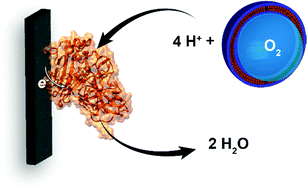Improving O2 reduction at an enzymatic biocathode: mimicking the lungs†
Abstract
Here, we demonstrate the use of phospholipid micelles to enhance O2 concentrations by two-fold at the surface of a bilirubin oxidase biocathode. Specifically, 1,2-diarachidoyl-sn-glycero-3-phosphocholine was used in a glucose enzymatic fuel cell to limit power losses due to O2 transport, even in a quiescent solution.


 Please wait while we load your content...
Please wait while we load your content...